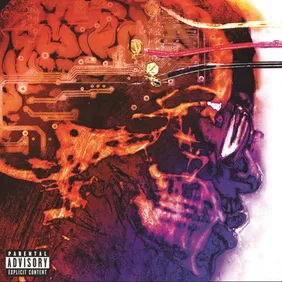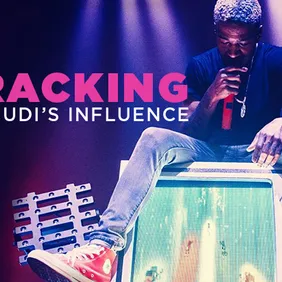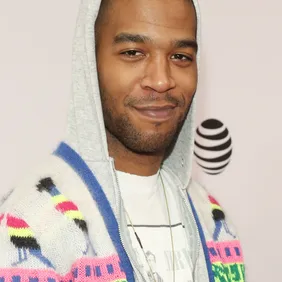In 2007, Kanye West experienced one of the most tumultuous years of his life. Graduation was released to widespread acclaim, and also proved to be a resounding commercial success, selling 957,000 copies in its first week to beat out 50 Cent’s Curtis in the highly touted sales competition. The anthemic, stadium-rocking style of songs like “Stronger” and “Can’t Tell Me Nothing” catapulted Kanye to newfound heights; it was the final nail in the coffin for gangster rap, and the coronation of hip-hop's next superstar.
Yet as the year wore on, Kanye’s life began to unravel. On November 10, his mother Donda West tragically passed away due to complications arising from cosmetic surgery. And a few months later, Kanye and fiancée Alexis Pfifer called off their engagement, bringing an end to their five year relationship. Lost and suddenly finding himself alone at the top, Kanye immediately turned to music to channel his emotional vulnerability. With the aid of a young artist from Cleveland by the name of Kid Cudi, Kanye would go on to create 808s & Heartbreak, the genre-defying release that altered the trajectory of contemporary hip hop.
Of course, Cudi wasn’t the only one who had a hand in crafting the aforementioned “pop art” masterpiece. The ground-breaking use of 808s and auto-tune vocal effects would not have been possible without the combined creative efforts of individuals such as Jeff Bhasker, No I.D., and Plain Pat. Still, there can be no denying Cudi’s impact on the album. On July 17, 2008, he released his debut mixtape A KiD Named CuDi, an artistically liberating project that was handled by producers Emile and Plain Pat. The 17-track tape featured hit record “Day ‘n’ Nite,” Cudi’s commercial debut single that reached number three on the US Billboard Hot 100 chart.
And while the Crookers remix of “Day ‘n’ Nite” went on to dominate the blogosphere, more astute listeners were quick to pick up on Cudi’s knack for melodic self-reflection on tracks like “Man on the Moon (The Anthem)”: “I guess if I was boring they would love me more/Guess if I was simple in the mind/Everything would be fine.” Cudi’s innate ability to convey emotion was profoundly relatable, and it attracted a great many fans who saw more than just a man rapping about being lost and misunderstood; the music was different, and as Cudi noted, that wasn’t a bad thing. His seamless blend of styles and willingness to experiment caught the eye of Kanye’s A&R at the time, Plain Pat, who met Cudi at a Def Jam meeting and picked up a copy of the aspiring artist’s demo. Eventually, the feel good melodies and stream-of-consciousness tunes made their way up to the founder of G.O.O.D. Music, ushering in a new era for the label and signaling the beginning of a remarkable partnership.
Kid Cudi - Day N Night
Man on the Moon: The End of Day is more than just an extension of the sound that Cudi and Kanye tapped into on songs off of 808s & Heartbreak such as “Welcome to Heartbreak,” “Heartless,” “Paranoid,” and “RoboCop.” It’s an autobiographical concept album that delves deep into the mind of a man who is plagued by anxiety, night terrors, and the expectations of others. Whereas A KiD Named CuDi offers more of a bird’s eye view, Man on the Moon: The End of Day looks inward and beyond. Cudi brings his dreamlike imaginings to life on the album over the course of five distinct acts, each one with its own feel. “Soundtrack 2 My Life” is the vibrant opening to Cudi’s dreamland, as he raps about the work ethic of his mother, the death of his father, and the subsequent depression that came to consume him. It’s a prelude of what’s to come: the pain, the loss, the feelings of insignificance, and the boundless introspection. The unnerving paradise of “Solo Dolo” is a look into Cudi’s darkest nightmares: being alone and unable to escape due to poor decisions. Characterized by eerie strings, it’s a vivid, horror-esque examination of a particularly bleak chapter of Cudi’s life.
“Day ‘n’ Nite” is the turning point of the album where Cudi pivots from the darkness of the past to the bright promise of the future. The upbeat, funky groove of “Enter Galactic (Love Connection Part I)” is a welcome reprieve, as Cudi launches into his psychedelic adventure. The Kanye West-produced “Make Her Say (I Poke Her Face)” is a playful and catchy track that flips Lady Gaga’s hook on “Poker Face” and turns it into a crude oral sex reference; it fits perfectly into the fantasy side of Cudi’s dream.
“Pursuit of Happiness (Nightmare)” is a melancholic return to self-examination from the perspective of an addict looking for their next hit. The happiness of the track is fleeting, confined within the limits of each high; it’s a glimpse into a search that seemingly will never come to an end. Cudi understands that the happiness of each addiction is only temporary and ultimately unsatisfactory, yet he can’t manage to break free of the cycle that always seems to end in failure. The opening lines of the chorus that echo Shakespeare are sobering, but there remains promise for a new beginning.
“Up Up And Away” is the final track that brings the album to an uplifting and energetic close. It’s a drug escapist anthem on which Cudi sets his sights on the “happy thoughts” that allow him to fly like Peter Pan. He is “perfectly at peace,” and content to “move along a bit higher” in an effort to further elude the troubling thoughts that race through his mind. Cudi’s realization that people are going to judge him regardless and that he may as well do whatever he pleases is a hopeful conclusion; it also seems to hint that the emotional rollercoaster voyage that he has dreamed of is only beginning.
Kid Cudi ft. MGMT & Ratatat - "Pursuit Of Happiness"
Cudi’s honesty about his mental health and use of hallucinogens on Man on the Moon: The End of Day was a novel approach for hip hop, and created the opportunity for artists such as A$AP Rocky, Chance the Rapper, Danny Brown, and Childish Gambino to further elaborate on such topics. In addition, his dedication to cross-genre experimentation was career-defining, and has informed how other artists choose to go about such collaborations. The inclusion of indie and electronic rock elements with the help of Ratatat and MGMT on “Alive (Nightmare)” and “Pursuit of Happiness (Nightmare)” weren’t Cudi’s first attempts at dabbling with other genres, but they are notable entries.
Drake, The Weeknd, and Travis Scott are a few of the most distinguished artists who have drawn inspiration from Cudi’s artistic approach on Man on the Moon: The End of Day. Drake needed the sounds that Cudi helped pioneer to create the cathartic So Far Gone, an intimate and emotional release that helped propel the Toronto rapper to unfathomable success. As for The Weeknd and Travis Scott, both of them latched onto Cudi’s transcendent melodies and the mental sanctuary that he carved out for himself on his debut album. In a 2015 interview with MTV News, Scott even went so far as to say that “There would be no Travis Scott if it wasn’t for [Cudi],” before tearfully sharing the story of how they first met. Travis’ work on Owl Pharaoh and some of the more contemplative, drug-infused moments on Days Before Rodeo bear unmistakable resemblances to Cudi’s style.
Kanye saw in Cudi someone who was capable of helping him bring the sounds he desired to life, a man who was building a sonic universe of the kind that he too wanted to create. On 808s & Heartbreak, the two developed a brooding, striking sound that combined Kanye’s vision and disillusionment with traditional hip hop with Cudi’s melodies and ability to fuse different styles. It was a project that shattered expectations and raised the bar for future releases within the genre. Without 808s & Heartbreak, there would have been no Man on the Moon: The End of Day. The sounds that Cudi first explored were carefully curated by Kanye; Cudi was the protege with raw, untapped potential, and Kanye was the maestro who helped that potential blossom into something that had never been heard before.
The foundation that Kanye laid on 808s & Heartbreak was exactly what Cudi needed to create his own experimental album. Cudi has always been unapologetically different, and Man on the Moon: The End of Day is the embodiment of everything that makes him so unique. He is the introvert who doesn’t fit in, but he never panders or oversteps. Whereas 808s & Heartbreak is a self-pitying monologue that features Kanye as the judge, jury, and executioner of his own pain and anguish, Man on the Moon: The End of Day is without regrets, as Cudi faces his inner demons. The abstract nature of his music isn’t condescending or isolating; instead, it is deeply personal and genuine in its focus. Rather than describing his external environment, Cudi looks inward in an attempt to make sense of the contents of his mind. His lyrics aren’t intricate, but his messages remain impactful. And while there are no witty punchlines or overarching metaphors, it is Cudi’s confessional style of delivery and spacey, atmospheric presentation of his music as a whole that make Man on the Moon: The End of Day so compelling.
Kid Cudi has inspired a generation of young artists to be unafraid to explore a wide array of emotions, and many have sought to adapt elements of Cudi’s music into their own. Never caring to fit into the conventional boundaries of music, Cudi became a voice for those who felt unrepresented and alone. His creativity on Man on the Moon: The End of Day is singular in its brilliance and innovation, and its influence continues to be felt both in hip hop and in popular culture.







